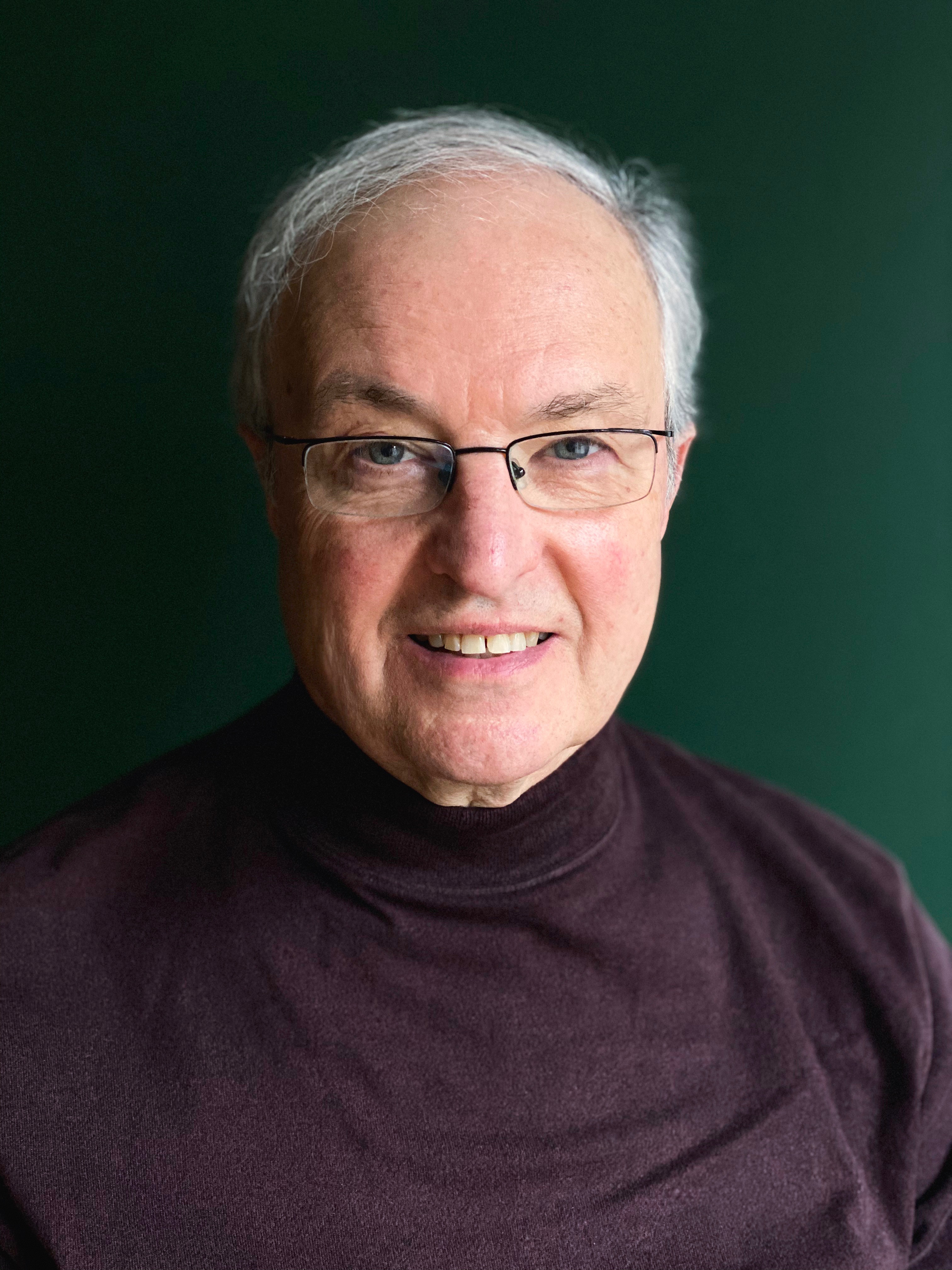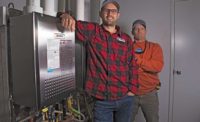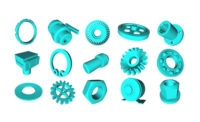The Visual Arts Building (VAB) at the University of Iowa is a marvel of both aesthetic design and mechanical engineering. Six years in the making and completed in October 2016, the award-winning, 126,000-square-foot structure blends the artistry of the renowned Steven Holl Architects (New York) with an array of innovative mechanical systems that smoothly integrate with Holl’s aesthetics while meeting the numerous, industrial-like requirements of this challenging space.
Thanks to these mechanical systems, the VAB is projected to consume 60% less energy than a building in compliance with ASHRAE 90.1. A verification report prepared by a local utility, MidAmerican Energy, converted that percentage into an annual cost savings of nearly $300,000. The utility calculated the final payback on the “incremental costs associated with energy conservation strategy investments” at a comparatively swift 2.1 years. For this project performance, the university earned an incentive payment of more than $550,000 for the building, which recently achieved LEED Gold certification.
“Every time we talk about this building and the incredible level of system integration throughout the space, I’m amazed we pulled it off,” said Amy Infelt, P.E., LEED AP — and only half-jokingly. Infelt is managing principal for the Cedar Rapids-based Design Engineers (DE), the VAB’s mechanical and electrical engineering consultant, for which she served as project manager. She was assisted by mechanical engineer Tim Lentz, P.E., LEED AP, and electrical engineer Eric B. Bruxvoort, P.E.
So many innovations
In her aforementioned comment, Infelt was specifically referring to the thermally activated slab (TAS) heating and cooling system her firm helped design with internationally renowned sustainability specialist, Transsolar, a KlimaEngineering firm based in Stuttgart, Germany. Providing baseline comfort for the five-story structure, this six-level slab system incorporates 67 miles, or more than 353,000 feet, of ⅝-inch Wirsbo hePEX™tubing, manufactured by Uponor North America in Apple Valley, Minnesota
However, Infelt could just as easily have been referring to the bubble-deck structural slab itself: The VAB is one of the few buildings worldwide to integrate TAS with void slab construction.
Or, she might have noted several other innovations that Transsolar brought to the project, such as:
- The metal-shading device that covers the windows on the southern and western sides of the building;
- The interior shading device that sits 10 feet below the 30-by-40-foot skylight over the atrium that spans the full length of the structure; or
- The insulated channel glass found at numerous points around the exterior.
Each of the above items is intended, in the service of both comfort and energy efficiency, to maximize the transmittance of light into the interior while minimizing heat gain or loss.
What drove all this innovation at VAB? Infelt credits the University of Iowa and its decision to recruit a highly regarded “design architect” to create an aesthetically compelling structure for the new home of the art and art history departments. This was necessitated when the predecessor building, which had been slated for extensive renovation, was ruined by a flood in 2008.
“You cannot overestimate the impact of having an architect of the international stature of Steven Holl,” said Infelt. “Their firm’s reputation rides on every building they create, so they pay incredible attention to every detail in the design and construction. This attention to detail inevitably impacts the design of all the mechanical systems in the building.”
At the same time, the university had also set very defined objectives for energy efficiency and energy consumption-reduction.
“Their focus is to design buildings for the lowest energy costs for the long term,” Inflet said.
SHA’s uncompromising aesthetics and the university’s lofty efficiency goals were not the only challenges for the mechanical system designers. The VAB is more than a building of offices and classrooms. It is also an active, buzzing, and humming collection of studio-art workshops, full of highly creative students busily making and building all manner of objects, which is why the building houses not one but 10 different dust-collection systems, pulling exhaust from woodworking and metalworking shops; a kiln room with seven industrial-grade kilns; a sculpture studio with a forge and a crucible furnace, an acid room for print-making; plus various studios for ceramics, painting, welding, and plasma-cutting — even bicycle-building.
In sum, the mechanical systems in this complex space had to maximize occupant comfort and productivity as well as overall system efficiency. The extent to which the structure’s designers and builders accomplished those twin objectives is a testament to the high level of collaboration within the building team. The latter included the Des Moines, Iowa, office of BNIM, which served as project architect, assisting SHA.
“Integrated design is a huge buzzword in the AEC world right now, but this building is truly integrated,” said Infelt, explaining how the mechanical systems DE and Transsolar created had to be designed to support the VAB’s overall aesthetic goals while meeting the widely varying needs of the many different users of the facility.
Among the highlights of the VAB, none is more architecturally striking than its atrium, which spans the entire 150-foot depth of the five-story structure and extends 70 feet vertically. Ductwork, piping, and conduit for mechanical, electrical, and plumbing systems are typically concealed above the ceiling in commercial buildings, but the VAB has very few ceilings, and the design intent was for the atrium to remain clear of any exposed MEP systems.
Everything is fully exposed through the rooms surrounding the atrium, including ductwork mains routed through a tunnel below the atrium. That meant its thousands of feet of piping and conduit had to be meticulously coordinated, so that systems were arranged in fastidiously neat and precisely parallel runs rather than the less rigorous style of most above-the-ceiling construction.
“We created what we called ‘utility routing zones’ — specific areas within each room through which all ductwork, pipe, and conduit could be routed with a special hanging system for each zone,” said Infelt. “We even coordinated how the piping and conduit were identified and labeled. All the systems are labeled with the identification in the same color and with identical graphics: black letters on a white background. The specific font and sizes of lettering were both coordinated by SHA.”
In short, no detail at the VAB was too small to escape scrutiny and close coordination.
Thermally activated slab system
As Infelt remarks in her firm’s own literature on the VAB, “The installation of the thermally activated slab heating and cooling system required especially close coordination.”
In part, that’s because the slab itself is not solid concrete but what is called voided biaxial slab, or bubble deck, construction.
The VAB bubble deck consists of hundreds of empty, but watertight, plastic balls — or the preferred term, “voids” — 7.5 inches in diameter and sandwiched between layers of criss-crossing rebar and all of it buried in 12.5 inches of concrete along with the Uponor Wirsbo hePEX. The latter, like most radiant installations, is laid out, six inches on center, in a serpentine fashion.
The special challenge for DE and the installing contractor: The Wirsbo hePEX had to be looped carefully into the slab in a way that avoided the voids (as well as all the rebar).
The rationale for this type of slab is straightforward enough: All those spherical voids allow for less concrete to be poured without lessening the thickness nor sacrificing the integrity of the slab itself. Less concrete means a smaller load, which in turn permits weight-bearing column spacing to be far wider — an absolutely critical need inside the expansive, SHA-designed atrium.
More frequently seen in Europe, this type of void slab remains a rarity in North America, especially in the Midwest. Equally rare in the Midwest is a TAS system that provides heating as well as cooling. Concerns about condensation leave many building designers reluctant to specify radiant cooling. However, the VAB uses TAS construction on six different levels.
“The system allows you to provide cooling in a way that keeps the slab surface temperatures above the point where condensation is produced,” said Infelt.
“What makes a TAS different is its use of the full concrete mass to store its heating and cooling longer,” she continued. “The six slabs at VAB contain no insulation, so a portion of the energy radiates upward. But the Wirsbo hePEX is positioned five-eighths of an inch from the bottom of the slab. As a result, most of the radiation is downward, conditioning the space below.”
Radiant was an obvious fit for the new VAB with its large, loft-like, atrium space. Whatever misgivings the university construction team and Controls and Maintenance Group might have had about radiant were largely resolved by an off-site visit to Chicago and to the Loyola University Information Commons, which uses a similar TAS system.
“The extended, 25-year warranty provided by the Wirsbo hePEX was also a key factor in ensuring the university’s comfort with the TAS,” said Infelt. “Uponor played a key role in bringing us up to speed on activated-slab heating and cooling technology and then worked closely with us on the VAB design.”
Of particular value were the thermal modelings on the heating and cooling capacity of the slab, performed by Uponor sales engineer Him Ly. Using the slab depth, the tubing diameter, the depth of the Wirsbo hePEX inside the slab, and the temperature of the water moving through the tubing, Ly calculated how many heating or cooling Btu per square foot the slab could provide.
“Once we understood the slab’s true capacity for heating and for cooling, we could best determine what supplemental systems were needed and what type of system would work best in a given space inside the VAB,” said Infelt.
All the Wirsbo hePEX was installed in the six slabs before any interior walls were set. This tubing was routed out of the slabs through 71 different manifold cabinets with 634 circuits or loops of tubing. Built into the walls, these cabinets contain isolation valves, balancing valves, and other hydronic accessories supplied by Uponor.
“The tubing is distributed via a supply-and-return manifold to a maximum of 12 loops per cabinet,” said Infelt.
The installed Wirsbo hePEX was left capped and hanging for an extended period, awaiting the construction of the interior walls and the final placement of the cabinets. How did the installation crews assure that none of the tubing was somehow damaged during this wait time?
“All the tubing was pressurized, and each of the 71 manifold cabinets was equipped with its own pressure gauge for its particular set of loops,” Infelt explained. “Once in the morning and once at the end of the workday, the installation team would inspect each of the 71 gauges, comparing the two readings. Wherever there was a pressure drop, the contractor knew something happened that particular day to damage the tubing. Doing these inspections daily made it easier to isolate and immediately fix any problems.”
Supplemental HVAC systems
The VAB TAS is a “passive” system with minimal active control whose mass can be counted on to retain heating or cooling capacity over long periods. But that consistency also prevents it from reacting quickly to changing loads — such as a busy classroom with large numbers of students regularly moving in and out of the space.
“The capacity of the slab to heat or cool is what it is — a constant,” said Infelt. “That is why we designated it the baseline heating and cooling system for the building. We then created extra heating or cooling capacity with our supplemental systems, which can react more quickly — and actively — to changing loads.”
The “changing loads” can be triggered not only by student and faculty movements about the building but also by the various specialized “industrial” processes taking place in its busy workshops. Another equally important factor is the weather extremes in Iowa, whose outdoor ambient temperature can range from subzero Fahrenheit in the winter to several days, even weeks, above 90°F in the summer. To help Transsolar understand the temperature ranges for the project area, Infelt would email them each time the area experienced temperature extremes.
Not surprisingly, DE ultimately chose to enhance Transsolar’s innovative TAS concept by adding supplemental HVAC systems that would support the teaching mission of the facility while fitting in with its structure and climate. These systems include:
Outdoor and exhaust air systems: This system provides general exhaust for the building occupants as well as exhaust from the industrial equipment and processes. In addition, these systems introduce outdoor air to provide ventilation air for indoor air quality, as required by ASHRAE 62.1, and to replace the exhaust air. These systems also maintain the building at a positive pressure relative to the outdoors. The outdoor air is delivered via variable air volume (VAV) terminal units with reheat coils and provides supplemental cooling and heating for the areas served.
Because of the number and type of industrial processes that occur inside the VAB, a considerable amount of makeup air from the outside is required for both replacement and ventilation air. This outdoor air is pretreated by a custom air-handling unit (AHU) that maintains separate airstreams: One running through a total energy, desiccant recovery wheel, and the second through a sensible heat pipe.
Located in the VAB’s lower-level mechanical room, the AHU pulls heat from some of the building’s exhaust before expelling it outdoors. At the same time, the air handler transfers that recovered heat to the incoming outdoor air before it moves into the building. This transfer is done through a slow-spinning desiccant wheel, handling the incoming interior exhaust on one side of the wheel and outgoing outdoor air on the other.
“We call it an ‘energy wheel because it allows us to transfer both latent and sensible energy, Infelt said.”
But not all exhaust is permitted to move through the wheel. Exhaust from the various industrial processes is, of course, dusty, smelly, and even hazardous, said Infelt, and therefore it may not be transferred to the incoming outdoor air. This exhaust airstream routes through the refrigerant-charged heat pipe, where its heat is recovered and transferred to the incoming outdoor air.
“The heat pipe is a heat-recovery device only,” said Infelt. “It can capture only sensible energy while keeping contaminants and odors on its side of the air-handling unit.”
While less efficient than the wheel, the heat pipe is still able to recover the heat from the exhaust from the industrial spaces.
Fan coil units: These units provide supplemental heating and cooling where the demand is beyond the capacity available from the TAS and ventilation air system.
Radiant heating, installed in designated places on the building perimeter: The TAS structural slab at the VAB is covered by a 3-inch-thick topping slab. Wherever insulated channel glass has been installed around the exterior, a 3-foot-wide strip of radiant heating — again using Wirsbo hePEX — was installed inside the topping layer. Controlled separately from the TAS system, this perimeter radiant install provides heating only during the colder months, shutting down in the summer. No insulation is used, because the 12.5-inch structural slab directs all the heating upward, where it is needed.
Single-zone displacement ventilation system: This energy-efficient system serves the 76-seat classroom by supplying air at a low — and therefore quiet — velocity, befitting an academic environment. The desired comfort temperature, where students and faculty congregate at floor-level (the “occupied zone”), is maintained, while the air space above is permitted to become progressively warmer as you near the ceiling.
Embracing the new
Post-construction tests have yet to be run, comparing the actual performance of the VAB with its ambitious, 60% savings target, but Infelt reports that the UI Controls and Maintenance Group, which is responsible for the building’s operation, has found the TAS and its supplemental HVAC systems to be very robust, providing a very comfortable environment for the occupants.
Given that the activated-slab system is such a good fit for large commercial projects with high-ceilinged, open areas, is DE looking to apply what it learned on the VAB to other commercial jobs? “We would sure like to,” Infelt responded.
“But TAS is still not a very common, accepted system. Going that route takes a client like the University of Iowa — a group or institution willing to embrace what is new and different to achieve something special,” she said.
Infelt recalls an early telephone conversation she had one evening a decade ago with Transsolar founder, Matthias Schuler, exploring whether they might collaborate on the VAB project.
“Transsolar develops the concepts and ideas for the new things they want to implement,” said Infelt. “But they need a mechanical engineer to partner closely with them — to make the plans and do the drawings and work with them to realize these new and innovative concepts.
“As an engineering firm, DE is fully committed to sustainability and energy efficiency,” she continued. “Where others might see uncomfortable risk, we saw great opportunity in working with someone like Matthias and Transsolar. By the end of our conversation that night, Matthias understood that DE was willing to partner with Transsolar, turning their innovative vision into an architectural reality.”











